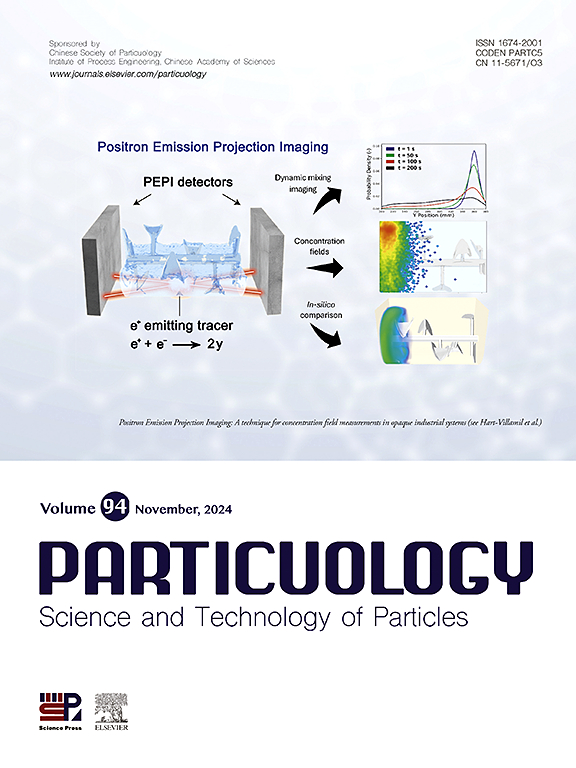爆炸驱动的亚毫米颗粒群的受控分散和速度演化:实验和数值模拟研究
IF 4.1
2区 材料科学
Q2 ENGINEERING, CHEMICAL
引用次数: 0
摘要
低附带伤害弹药在炮弹中加入了成千上万的亚毫米级重金属颗粒,取代了传统的金属炮弹。这些弹药实现了与常规弹药相当的近场破坏能力,同时依靠粒子的弥散衰减特性来控制破坏范围。然而,亚毫米级颗粒对爆炸驱动散射的分析提出了重大挑战。在本研究中,采用x射线试验捕捉爆炸载荷驱动下颗粒群的散射和弥散状态。采用离散元法(DEM)和有限元法(FEM)对散射演化过程进行了模拟。从控制粒子衰变的两相流力角度分析扩展速度场分布,揭示粒子群散射过程中的速度演变,并定性分析其影响因素。结果表明,在保证层状结构强度的前提下,结构壳中颗粒含量越低,越容易膨胀和破裂,颗粒群的散射能力越强。初始质点速度由爆炸能量和复合弹壳与炸药的质量比(M/C)决定。近场爆炸动力学涉及多相介质中激波、爆炸产物和颗粒群之间复杂的相互作用。相比之下,远场行为反映了由空气阻力驱动的粒子衰变,这与阻力特征时间有关。本研究提出了一种计算粒子群速度演化的方法,为低附带伤害弹药的工程设计和效果评估提供了有价值的见解。本文章由计算机程序翻译,如有差异,请以英文原文为准。

Controlled dispersion and velocity evolution of explosion-driven submillimeter particle groups: An experimental and numerical simulation study
Low collateral damage munitions incorporate tens of thousands of submillimeter heavy metal particles in the shell, replacing the conventional metal shell. These munitions achieve near-field damage capabilities comparable to that of conventional munitions, while relying on the dispersion decay characteristics of the particles to control the range of damage. However, the submillimeter size of particles poses significant challenger in analyzing explosion-driven scattering. In this study, X-ray test was used to capture the scattering and dispersion state of the particle groups driven by blast load. The scattering evolution was simulated using the discrete element method (DEM) coupled with the finite element method (FEM). The extended velocity field distribution was analyzed in terms of the two-phase flow forces governing particle decay, to reveal the velocity evolution during particle group scattering and qualitatively analyze its influencing factors. Ensuring the strength of the layer structure, results indicate that lower particle content in the structural shell promotes easier expansion and rupture, enhancing the scattering ability of the particle group. The initial particle velocity is determined by the explosive energy and the mass ratio of the composite shell to the explosive (M/C). Near-field explosion dynamics involve complex interactions among shock waves, blast products, and particles groups in a multiphase medium. In contrast, far-field behavior reflects particle decay driven by air resistance, which is related to the resistance characteristic time. This study presents a method for calculating particle group velocity evolution, offering valuable insights for the engineering design and effect assessment of low collateral damage munitions.
求助全文
通过发布文献求助,成功后即可免费获取论文全文。
去求助
来源期刊

Particuology
工程技术-材料科学:综合
CiteScore
6.70
自引率
2.90%
发文量
1730
审稿时长
32 days
期刊介绍:
The word ‘particuology’ was coined to parallel the discipline for the science and technology of particles.
Particuology is an interdisciplinary journal that publishes frontier research articles and critical reviews on the discovery, formulation and engineering of particulate materials, processes and systems. It especially welcomes contributions utilising advanced theoretical, modelling and measurement methods to enable the discovery and creation of new particulate materials, and the manufacturing of functional particulate-based products, such as sensors.
Papers are handled by Thematic Editors who oversee contributions from specific subject fields. These fields are classified into: Particle Synthesis and Modification; Particle Characterization and Measurement; Granular Systems and Bulk Solids Technology; Fluidization and Particle-Fluid Systems; Aerosols; and Applications of Particle Technology.
Key topics concerning the creation and processing of particulates include:
-Modelling and simulation of particle formation, collective behaviour of particles and systems for particle production over a broad spectrum of length scales
-Mining of experimental data for particle synthesis and surface properties to facilitate the creation of new materials and processes
-Particle design and preparation including controlled response and sensing functionalities in formation, delivery systems and biological systems, etc.
-Experimental and computational methods for visualization and analysis of particulate system.
These topics are broadly relevant to the production of materials, pharmaceuticals and food, and to the conversion of energy resources to fuels and protection of the environment.
 求助内容:
求助内容: 应助结果提醒方式:
应助结果提醒方式:


